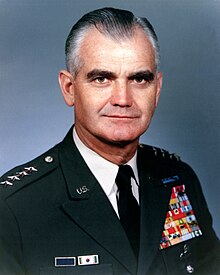General Westmoreland
| William Westmoreland | |
|---|---|
 |
|
| Birth name | William Childs Westmoreland |
| Nickname(s) | "Westy" |
| Born |
March 26, 1914 Saxon, South Carolina, U.S. |
| Died | July 18, 2005 (aged 91) Charleston, South Carolina, U.S. |
| Buried at | West Point Cemetery |
| Allegiance |
|
| Service/branch |
|
| Years of service | 1936–1972 |
| Rank |
|
| Commands held |
504th Parachute Infantry Regiment |
| Battles/wars |
World War II Korean War Vietnam War |
| Awards |
|
504th Parachute Infantry Regiment
187th Regimental Combat Team
101st Airborne Division
Superintendent of the U.S. Military Academy
XVIII Airborne Corps
Military Assistance Command, Vietnam
William Childs Westmoreland (March 26, 1914 – July 18, 2005) was a United States Army general, who most notably commanded U.S. forces during the Vietnam War from 1964 to 1968.
From Westmoreland’s arrival in South Vietnam in January 1964, his brief was to achieve outright victory over the Northern-backed Viet Cong, with minimal US casualties, without provoking the Chinese by attacks on the North. These demands were clearly contradictory, as even some of his critics acknowledged, and when casualties inevitably mounted, he was accused of pursuing a war of attrition. During his period of command, both the Battle of Ia Drang (Nov. 1965) and the Tet Offensive (Jan. 1968) were technically US victories, but public support for the war was diminished. By the time he was re-assigned as Army Chief of Staff, US military forces in Vietnam had reached a peak of 535,000. Westmoreland’s strategy, based on artillery and air power, was tactically successful but politically unsuccessful, as it resulted in large-scale casualties among non-combatants, which eroded American support for the war.
William Westmoreland was born in Spartanburg County, South Carolina, to Eugenia Talley Childs and James Ripley Westmoreland. His upper middle class family was involved in the local banking and textile industries. At the age of 15, William became an Eagle Scout at Troop 1 Boy Scouts, and was recipient of the Distinguished Eagle Scout Award and Silver Buffalo from the Boy Scouts of America as a young adult. After spending a year at The Citadel in 1932 he was appointed to attend the United States Military Academy. His motive for entering West Point was "to see the world". He was a member of a distinguished West Point class that also included Creighton Abrams and Benjamin O. Davis Jr. Westmoreland graduated as first captain—the highest cadet rank—and received the Pershing Sword, which is "presented to cadet with highest level of military proficiency". Westmoreland also served as the superintendent of the Protestant Sunday School Teachers.
...
Wikipedia
